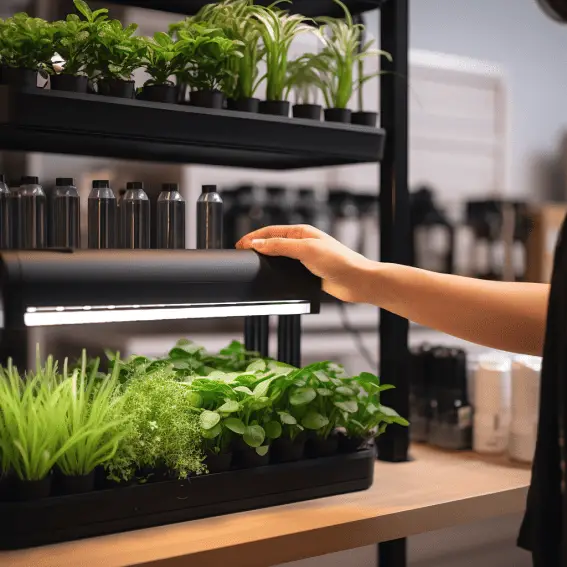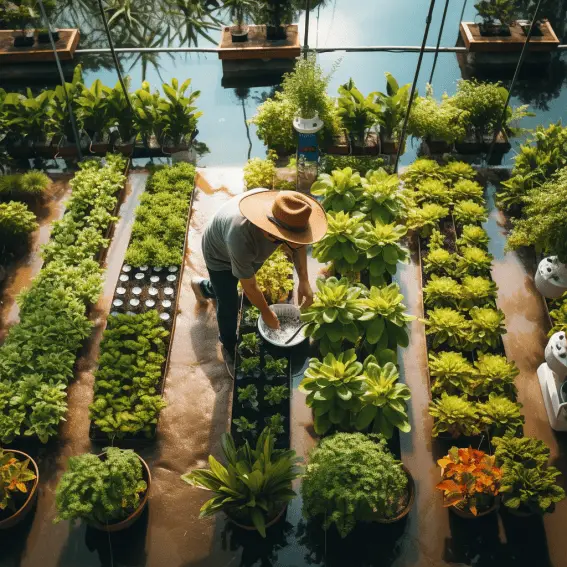Hey hydro homies! Picking the right water pump is key to keeping your hydroponic garden flowing smoothly. But with all the types, sizes, and specs of pumps out there, it can get confusing fast! No worries, I’ll make it simple for you.
Having the correct pump size and flow rate keeps your system circulating just right. Too weak and nutrients won’t reach your plants. Too strong and you’ll flood your grow space! By understanding how pumps work, calculating your needs, and finding the best fit, you’ll be pumping properly in no time.
Get ready to become a hydroponic pumping pro! I’ll walk you through how to size and select pumps so you can keep your system moving flawlessly. Let’s dive in!
KEY TAKEAWAY
What should you know about selecting a hydroponic water pump?
Selecting the right hydroponic supplies such as water pump is crucial for optimal plant growth and system efficiency. Consider factors such as flow rate, power consumption, noise level, and durability to make an informed decision and ensure successful hydroponic cultivation.
Understanding how hydroponic pumps work
Hydroponic water pumps help move nutrient solution through the system to the plant roots. They come in inline and submersible types.
Inline pumps sit outside the reservoir. They use a motor to turn an impeller that pushes the liquid through tubing to the grow beds or towers.
Submersible pumps go right in the reservoir. The underwater motor spins an impeller to pull liquid in and push it out a hose up to the plants.
Both create water flow and circulation to deliver nutrients. Without a properly sized pump (1), roots won’t get what they need to thrive!
Types of hydroponic pumps like submersible and inline

The two main types of hydroponic water pumps are submersible and inline (2). Here’s how they compare:
Submersible pumps go directly in the nutrient reservoir. They’re convenient but less efficient and need to be replaced more often.
Inline pumps sit outside the reservoir and use hoses. They’re more energy efficient and have a longer lifespan, but the plumbing is more complex.
For small hobby systems, a submersible pump is simpler to install and operate. Inline pumps are preferred for larger commercial hydroponic setups.
Let’s continue…
Calculating required flow rate (GPH) based on system size
The required flow rate, measured in gallons per hour (GPH), depends on the size of your hydroponic system. Here’s how to estimate it:
- Small hobby systems up to 10 gallons need a minimum of 100 GPH pump. Size up from there based on reservoir volume.
- Larger systems of 10-100+ gallons need higher GPH pumps, around 10% of total system volume. A 100 gallon system needs 1000 GPH pump.
- For continuous flow systems like NFT, calculate volume of all pipes and channels in addition to reservoirs when sizing the GPH.
- Factor in expanded clay pellets and other media which displace some volume. Media-filled beds need more flow and a higher GPH pump.
Take your time sizing up your system’s volume in gallons first. Then use a basic 10% rule to choose the right GPH for optimum circulation and nutrient delivery to your hydroponic plants.
Measuring head height from pump to highest point
The vertical distance that the pump moves water, called head height, must also be considered along with flow rate.
To measure it:
- Note the height from the top of the nutrient reservoir to the entry point of the grow bed or tower – the pump’s maximum lift.
- For the highest vertical tower, measure from pump to the tower top where water exits.
- Factor in any slopes or angled runs – measure the vertical change. Horizontal runs don’t affect head height.
This height determines how much lift the pump needs to push water to all areas. Combining it with flow rate GPH gives you your total pumping requirements.
Combining GPH and head height to properly size pump
To select the correct hydroponic pump, you need to consider both the required flow rate GPH and the system’s head height in feet.
Pump performance charts show the maximum GPH based on vertical lift height. Find the pump that meets or exceeds your needed GPH at the measured head height.
For example:
- A system needs 450 GPH flow rate
- The vertical distance is 5 feet
- The pump chart shows a 600 GPH pump can lift to 6 feet
- So this 600 GPH pump would work to meet the system requirements
Getting a pump that’s too small means insufficient flow and circulation. But too large wastes energy. Do the math to find just the right size!
Comparing pump wattage and efficiency
Look at pump power rated in watts, which affects operating costs and efficiency:
- Small submersible pumps use 25-50 watts. Larger inline pumps up to 250 watts or more.
- Pump efficiency is measured in GPH per watt. Aim for at least 500 GPH per watt.
- Less efficient pumps use more electricity to push the same water volume.
- Inline pumps tend to be more energy efficient than submersible types.
For hobby systems, pump wattage may not be a big concern. But for larger hydroponic farms, efficiency and costs add up – so compare and calculate!
Considering noise level, durability, and maintenance
Besides proper sizing and efficiency, other pump factors to consider:
Noise level:
- Submersible pumps are quieter since they’re underwater. Inline pumps can vibrate and hum.
- Noise matters more for indoor systems than greenhouse setups. Check decibel ratings.
Durability:
- Pumps contain moving parts that wear over time. Expect 2-3 years average lifespan.
- Ceramic/metal impellers last longer than plastic. Check manufacturer warranty.
Maintenance:
- Pumps need periodic cleaning as mineral buildup occurs.
- Submersibles are easier to access and clean. Inline require detaching tubing.
- Keep spare washers and impellers on hand for repairs.
Look at noise, lifespan, and maintenance needs when selecting a hydroponic water pump.
Choosing best pump type for different hydroponic systems
Certain pump types work better for some hydroponic setups:
- Simple wick and deep water culture systems do well with small, inexpensive submersible pumps.
- NFT and drip systems need reliable inline pumps able to provide consistent water flow and pressure.
- Media-filled beds like ebb and flow need enough GPH flow rate to flood the bed volume, requiring larger pumps.
- Aquaponics combines hydroponics with fish tanks needing extra filtration – dual purpose pumps are designed for this.
Consider your system type and needs when picking pump styles to make sure it fits!
Conclusion
There you have it! Now you can pick the perfect hydroponic water pump for your system’s needs. Calculate the flow rate, measure the height, combine them to size it right.
Consider the type, strength, noise level, and durability too for the best fit. Take it slow, test it out, and make adjustments as you go until the flow is flawless.
Thanks for learning how to select these important pieces of hydro equipment with me! Proper water circulation keeps your plants happy and growing strong. Put this pump picking knowledge to work on your hydroponic garden.
Before you know it, you’ll have your system flowing smoothly, nutrients reaching every root, and big beautiful plants pumping out fruits and flowers. Let me know if you have any other hydroponic questions!
Frequently Asked Questions
How often should I run my hydroponic pump each day?
Good question! Here are some general pump running guidelines:
- For small hobby systems, run the pump continuously 24/7 to keep nutrients circulating.
- For larger systems, use an intermittent cycle like 15 minutes on, 45 minutes off. This saves electricity.
- Run pumps more often during warmer weather when oxygen levels are lower.
- During seedling and clones stages, run pumps constantly to nourish developing roots.
- Turn off pumps briefly when changing reservoir or cleaning to prevent backflow issues.
- Use a timer if your pump doesn’t have auto on/off capability to automate cycles.
Adjust schedules based on system size, plant types, weather, and growth stages. But aim for at least 15-30 minutes of pump time per hour. Continuous flow is best for plant health!
How can I quiet a noisy hydroponic pump?
Noisy pumps can drive you crazy! Here are some tips to quiet them down:
- For submersible types, ensure it’s fully underwater and cushioned from vibrations.
- Place foam under inline pumps to prevent noise transfer through floors and walls.
- Use hose clamps to firmly secure hoses and prevent rattles.
- Buy quality pumps – cheap pumps tend to have issues with bushings wearing and rattling.
- Maintain pumps to prevent particles causing imbalance and noise in impellers.
- Move outdoor pumps away from windows as distance reduces perceived noise.
Look for quiet operation when shopping for pumps. But with some sound dampening fixes, even noisy pumps can be silenced!
How can I increase the flow rate if my pump isn’t strong enough?
If your hydroponic pump doesn’t seem to be providing enough flow, there are some troubleshooting steps to take:
- Double check your flow rate needs vs the pump’s specs – you may need a bigger GPH pump.
- Make sure there are no kinks or blockages in hoses limiting flow.
- Shorten vertical distances that the pump has to push water if possible to reduce head height.
- Confirm the impeller is clean – mineral deposits can impede flow over time.
- Reduce elbows and angles in your plumbing which restrict flow. Use wider, smoother hoses.
- For media-filled beds, expanded clay pellets can compact over time and limit water penetration.
- Use a flow meter to test output. If it’s less than rated, the pump may be wearing out.
- Add a second pump if necessary to work in tandem with the first pump.
What causes hydroponic pumps to lose efficiency over time?
With regular use, pump efficiency and flow rate can decrease for a few reasons:
- Mineral deposits accumulate on impellers and inside pumps, adding drag.
- Impellers and bushings simply wear out with use, especially cheap plastic parts.
- Algae and salt buildup occurs over months of operation.
- Motors lose windings or magnet strength, reducing power.
To maximize lifespan:
- Clean pumps regularly to reduce mineral/algae deposits.
- Use ceramic impeller shafts which withstand wear better than plastic.
- Buy quality pumps with replaceable components.
- Watch flow meter readings for early signs of reduced output.
With good maintenance and care, hydroponic pumps can stay efficient for years!
References
- https://www.agrowtronics.com/sizing-hydroponic-pumps-what-you-need-to-know/#:~:text=Choosing%20a%20flow%20rate,when%20all’s%20said%20and%20done.
- https://astralgrow.com/collections/water-pumps
Was this helpful?

Crystal Erickson is an agriculture enthusiast and writer with a passion for sustainable farming practices and community development. Growing up on a family farm in rural Iowa, Crystal developed a love for the land and a deep appreciation for the hard work and dedication required to make a farm successful.
After completing a degree in Agriculture and Environmental Science from Iowa State University, Crystal began her career as an agricultural journalist, covering stories and issues related to modern farming practices, crop management, and livestock production. She quickly established herself as a respected voice in the industry, known for her insightful reporting and thoughtful analysis.
Over the years, Crystal has written for a variety of publications, including Farm Journal, Successful Farming, and Modern Farmer, as well as contributing to several academic journals focused on sustainable agriculture and community development. Her work has been recognized with numerous awards, including the Iowa Farm Bureau’s Young Farmer Achievement Award and the National Association of Farm Broadcasting’s Farm Broadcaster of the Year.

